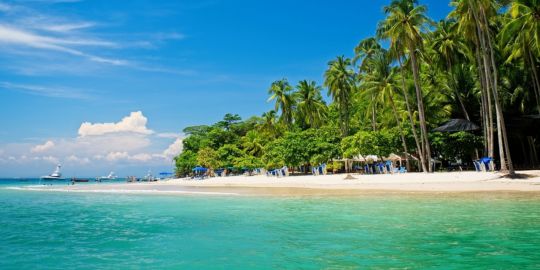Driving in Costa Rica

Although Costa Rica has a reliable public transport system, most people living in the Central Valley region drive their own car to conduct everyday activities, such as going to work, dropping children off at school, and running errands. Read this article to find out more about driving in Costa Rica.
Costa Rica has a good highway network ' and most of it is paved with adequate traffic signs in Spanish, so many popular destinations are easily accessible by road. Driving will allow you to set your own schedule and visit some more remote destinations that can be difficult to reach by public bus. Do be aware that some areas are not accessible without a four-wheel drive, so be sure to check in advance whether a 4Ã4 and higher clearance are necessary to access a place you wish to visit.
As most streets in Costa Rica don't have names, a lot of addresses end up being associated with a nearby landmark, and Costa Ricans use these reference points when they give directions ' such as '200 metres north of the church' ' instead of giving a specific address. You'll find that signs throughout the country are generally lacking, so a GPS can come in very handy. If you have a smartphone, it's worth downloading a crowdsourced traffic and navigation app called Waze, which can help you to get around. According to an article about the app published in The Washington Post, 'the country was mapped completely by volunteers who wanted to make it easier for their countrymen to get from point A to B. The app is especially popular in the capital, San Jose, boasting 300,000 active users.'
Information on road closures is also shared with Waze, so drivers using the app are all made instantly aware of any issues.
Conditions and regulations
Driving is an easy way to get around and get to know the country, but you may soon discover that there are different driving habits and regulations to what you are used to. Be prepared to drive on the right-hand side of the road in Costa Rica, and the speed limit on highways is 90 km/h (speed limits are posted in kilometres on signs). Fines are expensive (you could be fined more than US$500 for speeding if you are caught going over 120km/h), and driving under the influence of alcohol can even result in jail time.
Indicators are often ignored or not used, so be sure to look multiple times and be cautious when you change lanes on a highway. It's also important to always be alert, as dogs can wander across main roads and lots of drivers don't adhere to regulations. Road conditions vary across the country from well-paved two-lane highways to pothole-ridden dirt roads and roads without painted lines. Most roads in and around San Jose tend to be well maintained, but conditions can deteriorate in more rural areas. Keep an eye out for other drivers who have put on their hazard lights or are flashing their headlights to alert you of any problems.
When it comes to parking, you may notice that Costa Ricans don't leave much room for maneuvring. Consequently, it's worth parking in such a way that there is not enough space for another car to squeeze in, otherwise you may not be able to move away when you return to your car. Furthermore, try to use parking lots whenever possible as these are watched by security guards. Many restaurants and tourist attractions also have car attendants, which are often self-appointed watchmen who will watch your car in exchange for a small tip. It's wise to never leave anything in sight inside your car ' even things that aren't valuable to you.
There is a big difference between driving in downtown San José or Heredia and driving in smaller, touristic destinations. Almost half of the total population of Costa Rica lives in San José, so the main roads tend to be jampacked during rush hour. If you do need to drive in the city during peak periods, be careful at any cross sections, as many people drive quite aggressively and try to squeeze through without checking or indicating. The best times to drive in the big cities is between 9 am and 3.30 pm when there is less congestion.
Comparatively, you'll find that driving in Guanacaste or smaller cities is much easier, as the traffic is more fluid.
It's a good idea to always have an emergency kit in your car (especially if you intend to travel to rural areas) that includes enough food and water for two people to last 48 hours. You should also keep a warning triangle in the car boot in case you ever have an accident. It is required for drivers and front seat passengers to always wear a seatbelt while the vehicle is moving, and motorcyclists are required to wear helmets. However, you'll notice that in rural areas some locals don't wear helmets on motorcycles and seat several people on a scooter, so it's best to be extra cautious when around them on the road. Do also be aware of motorcycles and scooters weaving across lanes in San José, as they can get very close to cars.
Petrol stations all have the same government-regulated prices but can sometimes be quite far apart from one another, so it's advisable to fill up whenever you have the chance if you're driving a long distance.
It's also a good idea to keep some cash on you when driving, as toll booths are common on major highways, and you can pay for the toll in colones or bills of up to US$20.
Driver's licence
As a foreigner, you are allowed to drive in Costa Rica for up to 90 days, so long as you have a valid driver's license from your home country and a valid passport (you don't need to have an international driver's license). After that timeframe, you will need to get a Costa Rican driver's license, which is relatively easy to obtain.
If you have a valid license, it's easy enough to convert it to a Costa Rican license ' you will simply need to take an exam in Spanish (dictamen médico para licencia de conducir) and pay a small processing fee.
However, if your license has expired or you do not have a license, you will need to pass a driving test, as well as a written exam in Spanish in order to apply for a B1 Drivers License. You will also need to submit your passport and a medical certificate. As tedious as this may seem, it's still worthwhile to do if you plan to live in Costa Rica for a long time.
If you wish to rent a car while in Costa Rica, you will need to have a valid license from your home country or an international driver's license, be older than 21 years of age, and have a credit card.
Useful links:









